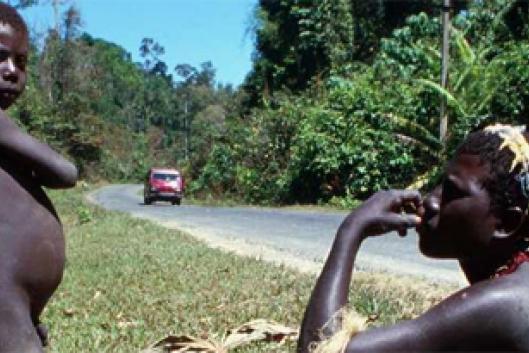Photo: Survival International
Another major threat looming over some groups of isolated indigenous peoples is mass tourism. In some cases, private operators and local guides organize flights over areas where these groups are known to live, for the entertainment of tourists.
On the Andaman Islands, “human safaris” are organized for visitors to take in a new tourist attraction: the Jarawa, a recently contacted tribe that has begun to relate with the outside world – although these relations take some very disturbing forms.
According to anthropologists, the Jarawa are descendants of some of the first humans to move out of Africa to other territories. They lead a simple life: the men hunt pigs and turtles with bows and arrows, and the women gather fruit and honey.
The Jarawa first began to venture out onto the roads and let themselves be seen in 1998. Two years earlier, a young member of the tribe, Enmai (see Stories of resistance in this edition) had broken his leg and was taken to a hospital, bringing back stories of the outside world upon his return. But this decision to break with their isolation has come at a high cost. As has been the case with numerous other previously uncontacted groups, they have succumbed to diseases to which they have developed no immunity: measles, mumps and even malaria. Some have adopted the vices of the outsiders: tobacco, alcohol and betel nuts (a mild stimulant).
Now the Jarawa tribe – made up of an estimated 403 members – lives on a reserve in the south of the Andaman Islands, which are located in the Bay of Bengal and belong to India. Although the Supreme Court of India ordered the closure of road that winds through the reserve in 2002, it remains open and attracts hundreds of tourist cars every day. At the entrance to the reserve, where the tourist cars line up, there are signs warning visitors of the rules: no pictures, no contact, nothing to disturb the tribe members, who are trusting, innocent and highly vulnerable to exploitation. There are police officers present, supposedly to protect them.
A journalist from the UK newspaper The Guardian, who was there to observe the situation, reports that as soon as the gates to the reserve opened, tourists began taking pictures, as well as throwing bananas and biscuits to the Jarawa on the roadside, as if they were animals in a zoo. The Guardian exposé included a video of Jarawa girls dancing for the tourists, in which a police officer, supposedly there to take care of them, is seen ordering one of the girls to dance.
At the Vyas Brothers shop in Port Blair, capital of the Andaman Islands, Jarawa handicrafts and small wooden figurines were displayed for sale. The shop clerk laid out the price of a day out on “safari” with the Jarawa: 15,000 rupees (USD 240) to buy off the police – who are supposed to keep tourists away but do quite the opposite – and another 10,000-15,000 rupees for a car and a driver, and for the Jarawa… little gifts.
This situation led Survival, an organization that works in defence of tribal peoples’ rights, to launch a campaign against these “human safaris”. In January of this year, in what appeared to be a victory, the Supreme Court of India temporarily banned tourists from entering the road that crosses through the Jarawa reserve. But two months later, this ruling was overturned, undoubtedly due to pressure from tourism operators and other business interests.
In response, in April, Survival launched a tourism boycott of the Andaman Islands, which has drawn the support of thousands of people who have pledged that they will not visit the islands until these excursions are brought to an end, as well as travel agencies that have removed the Andamans from their lists of tourism destinations (see http://www.survivalinternational.org/news/9239).
Colonization continues, in different forms, with different faces, but one of its most disgraceful facets is that of actions which humiliate, degrade and exploit isolated peoples, who are becoming increasingly hemmed in.
This article is based on: “Andaman Islands tribe threatened by lure of mass tourism”, Gethin Chamberlain, The Guardian, http://www.theguardian.com/world/2012/jan/07/andaman-islands-tribe-tourism-threat; “Thousands join travel boycott of India’s Andaman Islands”, Survival,http://www.survivalinternational.org/news/9239
